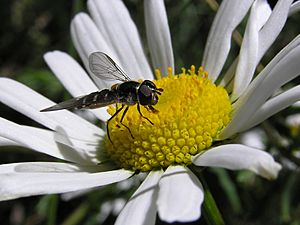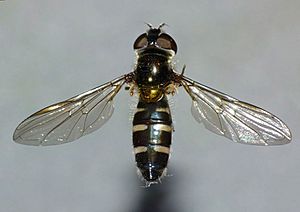Melangyna novaezelandiae facts for kids
Quick facts for kids Melangyna novaezelandiae |
|
|---|---|
 |
|
| Scientific classification | |
| Genus: |
Melangyna
|
| Species: |
novaezelandiae
|
| Synonyms | |
|
|
Melangyna novaezelandiae is a type of hoverfly that lives only in New Zealand. People often call it the "large hoverfly." This insect helps to pollinate many different plants, both those native to New Zealand and those brought from other places.
You can find M. novaezelandiae all over New Zealand, even in places where farmers grow crops. The young hoverflies, called larvae, eat other small insects. Because of this, they can be helpful for controlling pests in gardens and on farms.
Contents
About the Large Hoverfly
What it looks like
Most of the Melangyna novaezelandiae's body is a shiny metallic black, with a hint of green-yellow. Its eyes are a dark reddish-brown. On its belly, it has six cream-colored stripes arranged in three rows.
Tiny curly hairs cover its body. Scientists think these hairs help the hoverfly collect pollen. This hoverfly is usually about 7 to 10.4 millimeters long. Males and females look very similar. However, you can tell them apart by looking at their eyes: a male's eyes touch at the top of its head, while a female's eyes do not.
This hoverfly moves by flying quickly, then stopping and hovering in one spot.
Where it lives
Melangyna novaezelandiae is found throughout New Zealand. It even lives as far away as the Chatham Islands. You can find these hoverflies in many different places. This includes high subalpine areas and also on farms. In farming areas, M. novaezelandiae is one of the two most common types of hoverflies.
What it eats
The young Melangyna novaezelandiae, called larvae, are predators. They often eat aphids, which are tiny insects that can harm plants. They also eat other small creatures like scale insects and the larvae of moths. Because they eat these pests, hoverfly larvae can be used to help control insects that damage crops.
Adult M. novaezelandiae hoverflies eat plants. They feed on pollen to help their bodies grow and develop for reproduction. They also drink nectar from flowers for energy. This makes them important pollinators. Female hoverflies tend to eat more pollen than males. This is because developing eggs takes a lot of energy.
Scientists have found that these hoverflies eat pollen grains of different sizes. Because their diet changes as they grow from larvae to adults, scientists describe them as having "life history omnivory." This means they eat different things at different stages of their lives.
Life Cycle and Reproduction
Adult M. novaezelandiae are usually seen during the warmer months, from spring to autumn. This is also when the females produce their eggs. Female hoverflies lay their eggs very close to groups of aphids. Once the eggs hatch, the young larvae have a ready food source.
Pollination Role
Melangyna novaezelandiae are frequent pollinators. They help plants in both natural areas and on farms. Like many hoverflies, M. novaezelandiae is a "generalist pollinator." This means it visits many different kinds of flowers.
Observations show that the hoverfly will walk between flowers if they are close together. If the flowers are spread out, it will fly from one to another. In one study, M. novaezelandiae visited more types of flowers than any other pollinator. On farms, it was the second most common visitor to crop flowers. This suggests it plays an important role in helping crops grow.
However, some studies show that M. novaezelandiae is not as effective at transferring pollen as other pollinators like bumblebees or honey bees. This is likely because it does not specialize in pollinating just one type of flower.
Scientists have also found that M. novaezelandiae is most attracted to yellow colors. This color might help them find flowers.
Some of the flowers that M. novaezelandiae is known to visit include Trifolium pratense (red clover), Raoulia grandiflora, Leptospermum scoparium (manuka), Celmisia spectabilis, and different Melicytus species.
Where it came from
While there isn't much research on where this specific hoverfly first came from, some scientists think Melangyna novaezelandiae likely came to New Zealand from Australia. Australia has other types of Melangyna hoverflies, like M. viridiceps and M. damastor.


